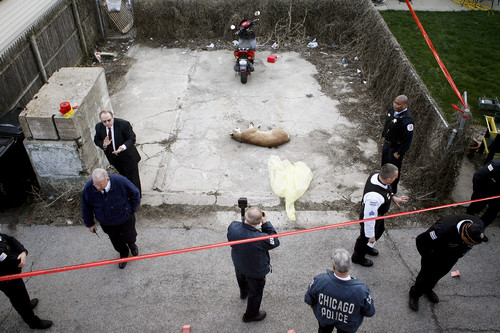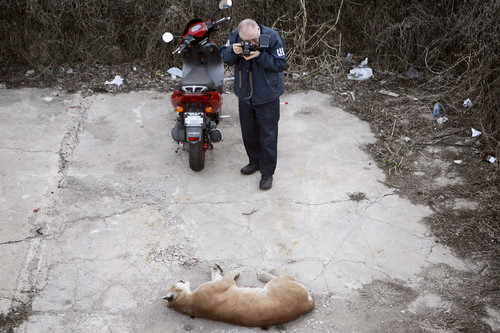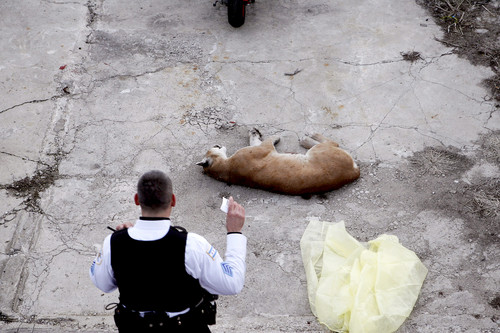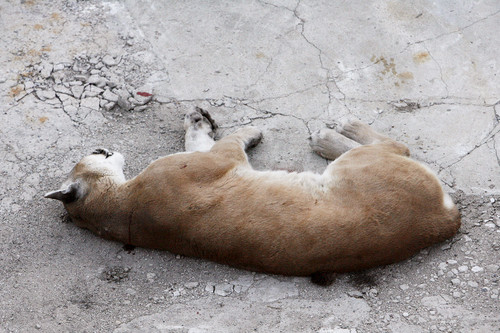Chicago Cougar Was Wild
Posted by: Loren Coleman on April 30th, 2008

A 124-pound cougar shot by Chicago police earlier this month is the same wild animal that was spotted in southern Wisconsin in January, Cook County officials said today, April 30, 2008.
DNA taken from the cat killed April 15 in Roscoe Village matches genetic material found in Rocky County, Wisconsin, following a cougar sighting there on January 15, 2008, authorities said.

The test results also confirm that the male cat shot in Chicago was a wild, free-roaming cougar, not an escaped exotic pet, officials said.
But more tests are still being done to determine where the big cat originated. The nearest wild population of the predator to Chicago is in South Dakota, experts have said.
“These findings provide a glimpse into the life of this wild cougar and are critical pieces of a larger puzzle, which for us and other agencies is where it came from and how and why it reached an urban area,” Dr. Donna Alexander, Cook County animal control administrator, said in a statement.
The animal — whose exact age is still being determined — measured 5 feet, 4 inches long from his nose to the base of his tail, authorities said.

Chicago Police had been pursuing reports of a cougar on the loose since March 29, 2008. It was shot by police on April 15 after they cornered it near Audubon Elementary School.
The animal was shot seven times, and a necropsy showed it died of shots to the right aorta, right heart base and right ventricle, officials said.
The cat’s remains are being kept at the Field Museum of Chicago for research, officials said.

Source: “DNA shows cougar came from Wisconsin,” by Dan Rozek, Chicago Sun-Times, April 30, 2008.
++++
Once again the blindness to the fact that wild populations of cougars might actually exist in Wisconsin and Illinois versus looking for an origin in South Dakota is revealed in this article.
About Loren Coleman
Loren Coleman is one of the world’s leading cryptozoologists, some say “the” leading living cryptozoologist. Certainly, he is acknowledged as the current living American researcher and writer who has most popularized cryptozoology in the late 20th and early 21st centuries.
Starting his fieldwork and investigations in 1960, after traveling and trekking extensively in pursuit of cryptozoological mysteries, Coleman began writing to share his experiences in 1969. An honorary member of Ivan T. Sanderson’s Society for the Investigation of the Unexplained in the 1970s, Coleman has been bestowed with similar honorary memberships of the North Idaho College Cryptozoology Club in 1983, and in subsequent years, that of the British Columbia Scientific Cryptozoology Club, CryptoSafari International, and other international organizations. He was also a Life Member and Benefactor of the International Society of Cryptozoology (now-defunct).
Loren Coleman’s daily blog, as a member of the Cryptomundo Team, served as an ongoing avenue of communication for the ever-growing body of cryptozoo news from 2005 through 2013. He returned as an infrequent contributor beginning Halloween week of 2015.
Coleman is the founder in 2003, and current director of the International Cryptozoology Museum in Portland, Maine.










Uh-huh…in Chicago, of all places…
Probably just some wild big cat. But…why on earth would it be wandering around Chicago, Illinois?
To repeat a quote from the original April 16th post of this story:
“A spokesman for the Illinois Department of Natural Resources said Monday that the state’s current wildlife code does not protect cougars because they are not considered a normal part of the ecosystem here”
Having established that this was in fact a wild animal, does that assertion still hold? What are the exact requirements for being a “normal part” of the ecosystem according to the Illinois Department of Natural Resources?
Are they suggesting that if some rare or endangered species (such as a bird), not usually seen in the area, was sighted in Illinois that it would be OK to hunt it, since it was not “normal” and therefore unprotected in their jurisdiction?
For example, when a new species (such as the frogs or legless lizards in the recent post) are discovered in a protected area of the Amazon, are they unprotected because they are (by default) not on a species list? What is required for a species to become recognized as “normal” for a given ecosystem? Is there some expert registration process?
If human acknowledgment of a species (by visual confirmation) was necessary to validate its existence, how do they explain the reliance of human existence on microbial processes for thousands of years?
G.Lawliet, it was probably early for fall enrollment at Northwestern.
I need more evidence than just a statement that the cougars DNA matched one that was sampled in Wisconsin… What are the chances of that?… It could be a statement that they concocted to make the story fit nicely alongside the other stories that they tell us.
ps.
Point Radix… I totally agree with u, its a clever catch 22…
Never mind the fact that they used to live there before they were supposedly completely extirpated… in Michigan its possible that they have existed in small populations since the extirpating effort, not to mention other parts of the Midwest and east coast.
Using that rational, any animal that has suffered near extinction at the hands of man and its population starts to rise again is threatened to be decimated again… its a good thing animals don’t have guns or we would be engaged in all out war… Problem is that they don’t comprehend the assault on there kind… poor animals
That cat could have originated in South Dakota. They can travel far distances. Especially if, when he was kicked out by mama, he couldn’t find any “free” land (all had been taken by other cougars for their territories). Cougars will take multiple acres as their territory (my parents have a double homestead with one cougar and babies). So, he was pushed further and further east. As the crow flies (or cougar wonders in this case) South Dakota really isn’t that far away. And why Chicago? Food. Free food and no one to compete with (that we know of).
Who’s to say that it was not taken from the wild as a kitten, then raised in captivity? The DNA would be the same as that of a wild puma in that case. I find it hard to believe that a wild puma suddenly chose an urban area for its habitat, when there is so much rural territory in Illinois where it could have gone instead.
I think that some people make the mistake in conceptualizing that wild animals divide up the world in the same way that humans do – into the rural vs urban, or rural, suburban, vs urban.
Step back a moment.
From most studies of wild animals in cities, these animals (including large felids) merely experience these “things” placed there by humans as being in the way of their old trackways, or serving as intriguing and interesting new challenges to getting from one greenbelt to the next.
Some of these places full of smelly primates even have chewy treats along the way (e.g. little dogs chained up in backyards), which make nice snacks during their journeys.
Interestingly enough, there was a post on cryptomundo today (May 1st) on the new species of Bolivian river dolphin, which was immediately “adopted by the Bolivian government as a symbol of the country’s conservation efforts”. That immediate recognition of a new species is probably the best way of dealing with new (or rediscovered) animals in terms of their conservation/protection (and thus deciding what is “normal” for the ecosystem) – unfortunately, it probably doesn’t work that way in most countries…
I live in Chicago, Illinois. I can tell you this much: If you want the General Assembly of this state to provide recognition to a rare species, it is important that you follow certain well-established steps. First, you must hire appropriately expensive lobbyists. After that, several golf outings in warm locations will likely be followed by steak dinners with fine brandy. These will be described as educational summits on the state of your species in the Illinois ecosystem.
At that point, you will succeeded in getting the necessary attention from legislators but not the Governor. A sizable birthday present to one of his children will do the trick. That will cause all of the state legislative wheels to turn.
Of course, none of that matters if Chicago’s Mayor Daley is not happy. This is Illinois where Springfield is the capital but Daley is the King. If your species can provide a lucrative maintenance contract to a Daley relative, you’ll be just fine.
More seriously, I think it is ironic that some of the comments have dismissed as unpursuasive DNA evidence linking the deceased cougar to sitings elsewhere. Isn’t that exactly the kind of evidence cryptozoologists long for but rarely get?
This isn’t that uncommon-seeing these cats in Illinois, that is. In the southern counties, there are black panthers roaming free in the woods. Many people in the area remain skeptical, but many others have witnessed them in trees, running, or out and about in early morning/late night. Seeing something so big and distinctive is not an experience you could mix up with another.
There was a rumor that the government actually release them into the public to control the deer population many, many years ago, but I really don’t know if there’s any truth to that. It doesn’t seem like an even solution.
“…critical pieces of a larger puzzle, which for us and other agencies is where it came from and how and why it reached an urban area…”
What’s puzzling? As anyone from British Columbia will tell you, cougars can and do venture into urban areas. In Victoria they’ve shown up in all sorts of seemingly unlikely places: the underground parking garage beneath the city’s conference center, inside the offices of a plastics manufacturer…one even crashed through a window into a home in the touristy James Bay neighborhood (in the cougar’s defense, it was being chased by dogs at the time).
In Los Angeles there have been recent incidents in Altadena and in Orange County (the latter being the fatal attack on the cyclist in Whiting Ranch Park, which is literally 10 miles from Disneyland).
Other recent incidents have come from such places as:
– Olympia, WA
– downtown Omaha
– Denver
– Kansas City
The point is, if cougars are in the vicinity then you can expect them to show up in the suburbs and even in the city every now and then. Why did this cougar show up in Chicago? The simple and obvious explanation is because there are cougars in Illinois, just as there are cougars in B.C. and Washington and California and Nebraska and Colorado and Missouri. They’re there, and sometimes they wander into town. It’s no more puzzling than that.
You can declare them extinct or extirpated or whatever, but that doesn’t mean the cougars will cooperate.
Tell me this, if you where a big cat how would you communicate to humans? is up to them to reach you or you to understand them? and yes they are every where.
Although not common, it does happen more frequently than you would expect here in southern California (Cougars roaming into suburban areas). I live just north of Ontario (cal) airport, and we usually get one or 2 a year wandering into neighborhoods. Most of the time it is when the weather is very hot or during a drought.